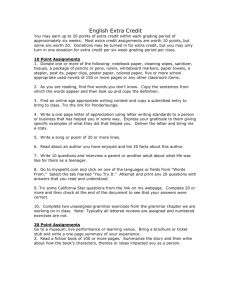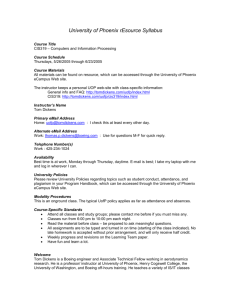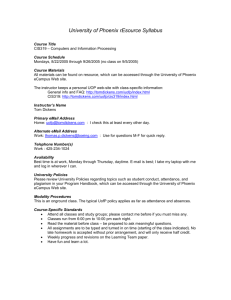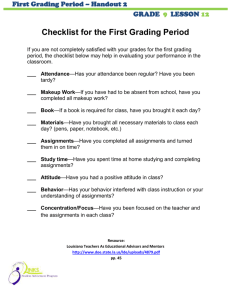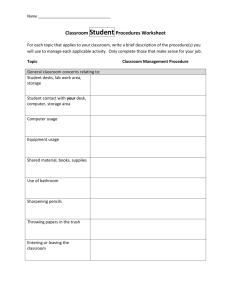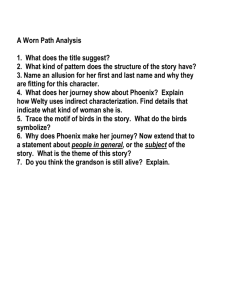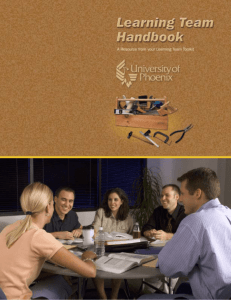university of phoenix - West-Point.ORG, The West Point Connection
advertisement
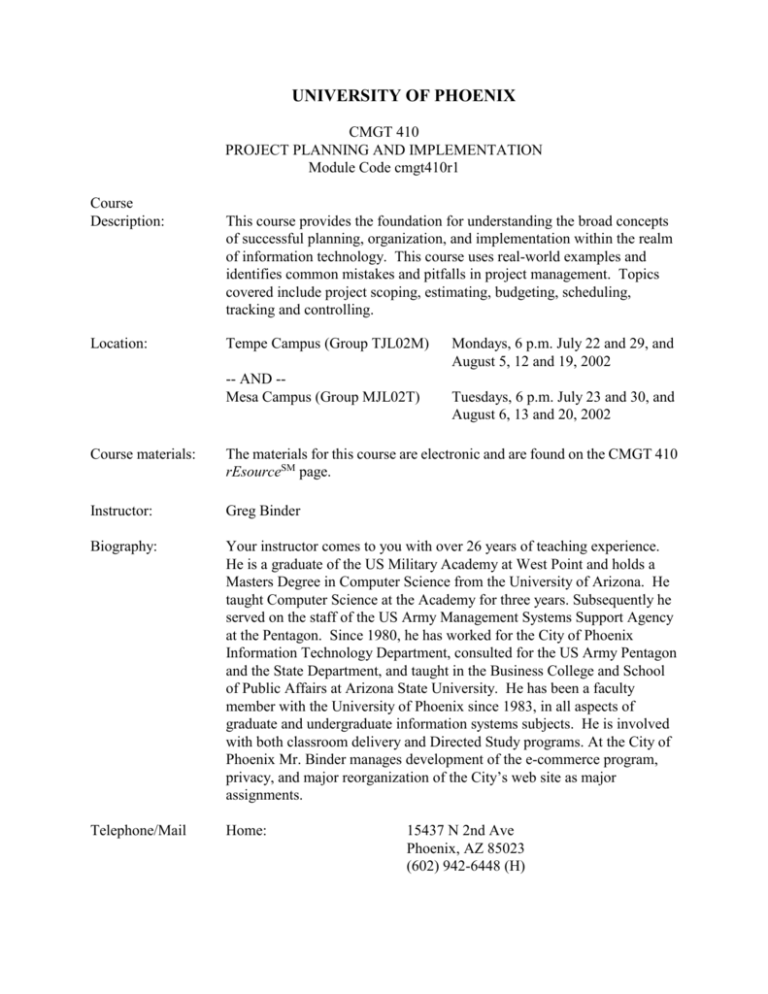
UNIVERSITY OF PHOENIX CMGT 410 PROJECT PLANNING AND IMPLEMENTATION Module Code cmgt410r1 Course Description: Location: This course provides the foundation for understanding the broad concepts of successful planning, organization, and implementation within the realm of information technology. This course uses real-world examples and identifies common mistakes and pitfalls in project management. Topics covered include project scoping, estimating, budgeting, scheduling, tracking and controlling. Tempe Campus (Group TJL02M) -- AND -Mesa Campus (Group MJL02T) Mondays, 6 p.m. July 22 and 29, and August 5, 12 and 19, 2002 Tuesdays, 6 p.m. July 23 and 30, and August 6, 13 and 20, 2002 Course materials: The materials for this course are electronic and are found on the CMGT 410 rEsourceSM page. Instructor: Greg Binder Biography: Your instructor comes to you with over 26 years of teaching experience. He is a graduate of the US Military Academy at West Point and holds a Masters Degree in Computer Science from the University of Arizona. He taught Computer Science at the Academy for three years. Subsequently he served on the staff of the US Army Management Systems Support Agency at the Pentagon. Since 1980, he has worked for the City of Phoenix Information Technology Department, consulted for the US Army Pentagon and the State Department, and taught in the Business College and School of Public Affairs at Arizona State University. He has been a faculty member with the University of Phoenix since 1983, in all aspects of graduate and undergraduate information systems subjects. He is involved with both classroom delivery and Directed Study programs. At the City of Phoenix Mr. Binder manages development of the e-commerce program, privacy, and major reorganization of the City’s web site as major assignments. Telephone/Mail Home: 15437 N 2nd Ave Phoenix, AZ 85023 (602) 942-6448 (H) Office: (602) 256-3589 (W) Electronic Mail Address: gbinder@email.uophx.edu gbinder69@uswest.net gbinder@ci.phoenix.az.us Web site address: http://www.users.qwest.net/~gbinder69/ Availability: Mr. Binder can be reached by any means above. In many cases, you will have to leave a message, however, he will return your contact as soon as possible. You may call the work number at any time. Home calls should be limited to 7 a.m. to 10 p.m. For sending documents by e-mail using the Internet, use the following address: gbinder@email.uophx.edu Assignments: It is my intention to follow, fairly carefully, the guidelines expressed in the module as to assignments and administration. Please do not be misled: you are responsible for the material in the assignments. The following specific guidelines are provided: The Learning Team will be used as a major vehicle in the various class activities, both during workshops and in outside assignments. Established teams will be modified to accommodate changed in class enrollment. As with many University courses, class participation is a valued attribute, contributing to the final grade. Several other measures of student performance are noted in the Grading Criteria. Grading: % 95-100 91-94+ 87-90+ 83-86+ 80-82+ 78-79+ Please remember: A= B= C= D= F= Grade A AB+ B BC+ % 75-77+ 72-74+ 68-71+ 65-67+ <65 Grade C CD+ D F Excellent performance. Above average performance Average performance. Accomplishes only the minimum requirements. Oral and written communication is at an acceptable level for an undergraduate student. Meets minimally acceptable levels of performance. Does not meet the most minimal requirements of the course. All written work (does not include homework questions) will be according to APA or MLA guidelines. Your grade will be based on style, content and format including such items as clarity of communication, sentence and paragraph construction, punctuation, spelling, and grammar. Late work will be docked 10%. If you are unable to complete the coursework you should seek guidance from your academic counselor – as a matter of University policy, incompletes are not granted. Course Standards: The University of Phoenix Adult Teaching Learning Model is based on the assumption that in preparation for every course, students will satisfy all prerequisites. During the course itself, students will achieve certain learning outcomes. All performance assessment depends upon the accomplishment of these outcomes. Students are graded on achievement, rather than effort. It is the responsibility of the student to come to class prepared for each workshop. The University trusts that each student will maintain high standards of honesty and ethical behavior. All assignments submitted in fulfillment of course requirements must be the student's own work. All assignments except those designated as "team" are meant to represent the effort of each individual student. Team projects and assignments should represent equal efforts by all team members. While the University's Teaching/Learning Model emphasizes the sharing of professional experiences in the context of analyzing relevant course materials, it is against the policy of the University of Phoenix for students or faculty members to share information in class about present or past employers that would be considered proprietary, confidential, company sensitive, or trade secret. It is assumed that students will perform professionally in preparing work required for this class. Attendance: Attendance at all class sessions is mandatory. Absences: If an absence is necessary, the student must contact the faculty member. Second absences are not allowed. Please note: An absence may affect the student's grade. Other: During the following workshops, graded activities will be conducted (with point value indicated): DUE IN W/S 2 3 4 5 5 WHO Individual Individual Individual Team Individual WHAT Generic Project Plan Expanded Generic Project Plan Training Project Plan Final Paper Final Paper Presentation FORM Written Written Written Written Oral POINTS 100 100 100 100 50 All All Individual Individual Class Participation Learning Team Participation 50 40 TOTAL 540 Grading for Written Work 50% Content/Development All key elements of the assignment are covered in a substantive way Content is comprehensive, accurate, and/or persuasive Major points are stated clearly, are supported by specific details, examples, or analysis and are organized clearly Where appropriate, the paper supports major points with theory relevant to development of the ideas, and uses the vocabulary of the theory correctly There is integration of theory and practice whereby the writer is able to link theories to practical experience Research is adequate and timely for the topic The context and purpose of the writing is clear 20% Organization The structure of the paper is clear and easy to follow The paper’s organization emphasizes the central theme or purpose and is directed Paragraph transitions are present and logical, and maintain the flow of thought throughout the paper The conclusion is logical and flows from the body of the paper The conclusion reviews the major points toward the appropriate audience Ideas flow in a logical sequence The introduction provides sufficient background on the topic and previews major points 10% Format The paper, including citations and the reference page, follows designated guidelines for format The paper is laid out effectively and uses reader-friendly aids (e.g., sections, summaries, tables of contents, indices, appendices, etc.) when appropriate The paper utilizes references appropriately Headings, the use of italics, etc., aid the readability of the paper and are not overdone The paper is neat, with attention given to format requirements Original work 10% Grammar/Punctuation/Spelling Rules of grammar, usage, and punctuation are followed Spelling is correct 10% Readability/Style Sentences are complete, clear and concise Sentences are well-constructed with consistently strong, varied structure Sentence transitions are present and maintain the flow of thought Words used are precise and unambiguous The tone is appropriate to the content and assignment Grading for Oral Presentations 20% Organization and Structure Presentation is well-organized, clear, and effectively structured If this is a team presentation, it is integrated rather than a disjointed series of individual presentations Topic is researched adequately 10% Effective Use of Visual Aids Visual aids are clear and effective Visual aids contribute to a focused and integrated presentation 50% Content of Presentation Content of presentation clearly follows the written paper on which it is based (if applicable) The topic is relevant and addresses the specifications of the assignment The content presented is comprehensive, accurate and believable Key points are noted and presented logically 10% Style, Presentation, and Appearance Dress and grooming are professional and appropriate for the setting Non-verbal gestures are appropriate to the purpose of the presentation and flow of ideas Confidence and knowledge of content are evident Audience is engaged, when appropriate, in a professional manner Delivery time is used well-presentation is not rushed Speaker adheres to the time limit 10% Questions and Comments Audience feedback is solicited Audience questions are effectively addressed and correctly answered
